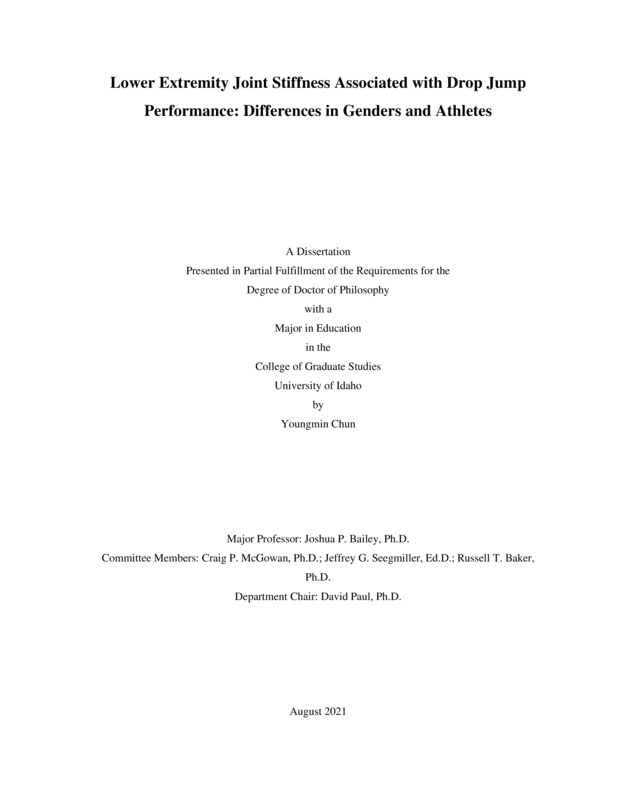Lower Extremity Joint Stiffness Associated with Drop Jump Performance: Differences in Genders and Athletes
Chun, Youngmin. (2021-08). Lower Extremity Joint Stiffness Associated with Drop Jump Performance: Differences in Genders and Athletes. Theses and Dissertations Collection, University of Idaho Library Digital Collections. https://www.lib.uidaho.edu/digital/etd/items/chun_idaho_0089e_12176.html
- Title:
- Lower Extremity Joint Stiffness Associated with Drop Jump Performance: Differences in Genders and Athletes
- Author:
- Chun, Youngmin
- ORCID:
- 0000-0003-4803-5336
- Date:
- 2021-08
- Program:
- Movement & Leisure Sciences
- Subject Category:
- Biomechanics
- Abstract:
-
A vertical jump task is often performed in combination with a preceding movement which targets activation of the stretch-shortening cycle by a series of eccentric and concentric muscle contractions. Properties of the soft tissues involved can be altered by an athlete’s training program, which may enhance their ability to effectively transfer stored elastic energy to maximize performance. Joint stiffness represents the potential ability of an individual joint to resist the external load and contribute the combined lower extremity resistance to an external load. The connection between joint stiffness and jump performance is related to the ability of the structures to store and return of elastic energy through potential manipulation to the angle-moment relationship. Joint stiffness is typically represented by the slope of the line of best-fit obtained by a linear regression model, which indicates the average joint stiffness throughout the entire eccentric or contact phase. However, the linear regression method did not fully represent the curvilinear angle-moment relationship of specific joints during the drop jump task, suggesting that joint stiffness should be calculated using a curvilinear relationship. Furthermore, it was found that the eccentric phase was more accurately represented when the eccentric phase was subdivided into loading and absorption subphases. Therefore, the overall purpose of this dissertation was to investigate the potential relationship between joint stiffness and drop jump performance with the application of a novel method to calculate joint stiffness. To address this purpose, three separate manuscripts were conducted generated from by two independent data collections. The benefits of utilizing a 2nd order polynomial regression model when calculating lower extremity joint stiffness incorporating subdivided eccentric phases was addressed in the first manuscript. The polynomial regression model had greater goodness-of-fit than the linear regression model for all joint stiffnesses. Differences were found between the two models for hip and knee stiffness during the loading and absorption phases. These results suggest that the polynomial regression model is a more accurate representation of the angle-moment relationship while subdividing the eccentric phase a drop jump into phases. Sex differences in lower extremity joint stiffness during vertical drop jump performance and potential sex differences between this relationship were the focus for manuscript two. Males had greater hip and ankle stiffness during the loading phase, knee stiffness during the absorption phase, GRF2, net jump impulse, and jump height than females regardless of box height. The 60 cm box increased all joint stiffnesses during the loading phase, knee and ankle stiffness during the absorption phase, and GRF1. Hip and knee stiffness during the loading phase predicted jump height of females whereas the joint stiffness was not related to males’ jump height. These results suggest that females have different lower extremity joint stiffness strategies than males to achieve the drop jump. The primary purpose of the final study was to examine differences in jump performance and joint stiffness between groups of female collegiate athletes (Basketball/Volleyball: BV, Dancers: DAN, Soccer: SOC). A secondary purpose was to identify the relationship between drop jump performance and both joint stiffness and isokinetic strength. The BV group had significantly greater jump height and jump impulse with reduced hip joint stiffness during the loading phase than the DAN group. No differences in isokinetic strength were observed between groups. Hip concentric and knee eccentric extension peak torque were significant independent variables within the overall regression model (p < .05, adjusted r2 = 0.196). The individual group regression models included different stiffness and isokinetic variables as predictors. This study supported the hypothesis that female athletes may achieve their max jump height through different strategies based on predictors of each regression model. These differences may be related to the sport specific training and adaptations due to the demands each sport has. In conclusion, these findings suggest that while testing lower extremity joint stiffness, the eccentric phase of the landing task should be divided into sub phases with a 2nd order polynomial stiffness calculation. Furthermore, predictors for jump height during a drop jump task are different not only across sex, but within the female population with respect to their sport and training history. The goals for each individual athlete may determine the strategy by which they utilize the stretch shortening cycles of the muscle-tendon units. It is however important to note that the task performed may not have a direct implication for performance within each sport.
- Description:
- doctoral, Ph.D., Movement & Leisure Sciences -- University of Idaho - College of Graduate Studies, 2021-08
- Major Professor:
- Bailey, Joshua P
- Committee:
- McGowan, Craig P; Baker, Russell T; Seegmiller, Jeffrey G
- Defense Date:
- 2021-08
- Identifier:
- Chun_idaho_0089E_12176
- Type:
- Text
- Format Original:
- Format:
- application/pdf
- Rights:
- In Copyright - Educational Use Permitted. For more information, please contact University of Idaho Library Special Collections and Archives Department at libspec@uidaho.edu.
- Standardized Rights:
- http://rightsstatements.org/vocab/InC-EDU/1.0/

